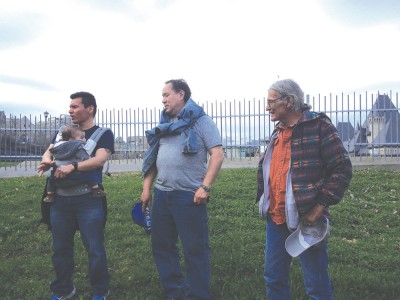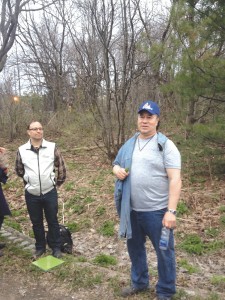There aren’t many people – especially people from Eeyou Istchee – who think of Montreal as a place where nature flourishes. Even Parc Mont-Royal, known to locals as “the Mountain,” is less of a natural place than a carefully tended park teeming with joggers and mountain bikers.
But Montreal preservation group Friends of the Mountain hoped to change the way some citizens understand the nature in their midst with “Mount Royal Flora: The Forest and the Human Story,” a walking tour of the Mountain’s plants and trees that took place May 9.
Friends of the Mountain member Éric Richard and Kahnawake Faith-Keeper Darrell Thompson, who explained the traditional uses of the Mountain’s natural bounty in Mohawk culture, guided the tour. The hike up the mountain began with an introduction by McGill’s Aboriginal Outreach Administrator Kakwiranó:ron Cook, who was accompanied by both his Elder father and his infant son.
When French explorer Jacques Cartier turned up in 1535, Montreal was then known as Hochelaga, a thriving community of 3,000. Behind a wooden palisade, the village contained 50 longhouses, and outside its walls, the community foraged for fruits, nuts and medicine in the woods and cultivated fields of the Three Sisters: corn, squash, and beans. Cartier himself described the land surrounding the Mountain as “ploughed and very fertile.”
Historians aren’t sure where the village was, but agree that it was someplace in the vicinity of the present-day site of McGill University. The Nation wasn’t Mohawk, as many might assume, but was actually a people that the Europeans called St. Lawrence Iroquoians – one of about a dozen communities who spoke Laurentian Iroquois.
By the time Samuel Champlain arrived in 1608, the St. Lawrence Iroquoians of Hochelaga were gone. There is great argument about what happened; some historians contend that were wiped out by intense battles with the Iroquois (Haudenosaunee) League, the Huron (Wendat), or by various Algonquin Nations. Some blame European diseases. Others caution that it serves the interests of French colonial history to say the St. Lawrence Iroquoians simply “disappeared,” and that it is more likely that the group dispersed into other Iroquoian communities for safety from both traditional foes and arriving Europeans.
Few Montrealers are aware that their city sits atop the site of a previous community, so the Friends of the Mountain began their walking tour with a 20-minute lecture on the history of the place, and the gradual shift in control of the land from Aboriginal communities to European settlers. With the rise in European domination, locals came gradually to forget that the Mountain had been a place that provided food and medicine for hundreds of years.
The Black Walnut tree, for example, was not originally native to the region, explained Richard, but was most likely transported here from the area now known as southern Ontario by Iroquoian people. Nuts were an important part of their diet, but as Thompson was quick to point out, the nuts’ skins can also be taken with water as a kind of detoxification diet at the end of a winter.

Kakwiranó-ron Cook and his son, with his father (right) and Darrell Thompson at beginning of mountain walk
Wild leek, sugar maple, red pine, willow, white pine and many other wild plants and flowers used for centuries all still grow on the mountain, and have traditional uses likely unknown to the average Montrealer (who, the organizers cautioned, should not pick plants for medicine on the Mountain, since the city is too populous to provide enough for all). Their sap, bark, buds, fruit and ashes can be used in many different ways, Thompson explained.
“You have to have a clear mind when you gather herbs,” he said. “They won’t be shy if you’re in the right place.”
Standing in front of a small marsh area in the woods of the Mountain, where the runoff from the winter’s snow collects, he pointed to the bark of the white willow tree.
“When you have problems, you come to the willow tree. Willow trees are famous for taking heaviness away from you. You know that saying, ‘Hug a tree’?”
“Do you have to hug it?” asked a young boy on the tour.
“That’s just a figure of speech,” laughed Thompson. “But the willow is famous for being what they make Aspirin from. Our people use it too. You scrape the top layer to get to the inner part. You take handfuls and you boil it in a pot. If you have a headache, drink a cup, or if you’re achy, you can bathe in it. It takes the pain away. When you’ve got problems, a bath in willow removes a lot of stress. You would not believe how good you feel.”
The walk ended at the site of a white pine planted in 2001 to commemorate the 300th anniversary of the signing of the Great Peace of Montreal, between the French settlers and 40 Aboriginal Nations drawn from the Iroquois Confederacy as well as Huron and Algonquian Nations. Because the needles of the white pine come in bunches of five, Thompson explained, they represent the five Nations of the original Iroquois Confederacy living in peace with one another.
“But the white pine is also about health, welfare and longevity,” he continued. A branch the length of a man’s forearm simmered for no more than 20 minutes in a gallon of water, Thompson said, “will provide medicine for just about anything. It’s good for heart because it builds elasticity in your arteries, and it’s good for the skin. It keeps you looking young.”
Speaking afterward, Thompson said he wanted both to encourage descendants of European settlers to see the value in the nature around them, and to bring young Native people back to their cultures. He was especially dismayed at young people who had no taste for their culture’s traditional food (like, he suggested, boiling the ashes of red oak with hominy corn, then adding beans and squirrel, deer or moose meat, for a meal exploding with calcium and protein).
“The problem is when our children are given those old foods, they won’t go that direction,” he said. “Right now there’s so many who won’t follow that diet. They only know MacDonald’s. So when you bring them to a ceremony and give them the traditional foods, it’s the strangest food in the world to them, because they’ve never been accustomed to it.”
Too often, Thompson said, people think of the natural world as a distant supermarket, infinitely renewing itself for them so they can have as much wood, paper, meta, and minerals as they want without consequence. He cautioned that his purpose was to warn city-dwellers away from that attitude.
“If I could have everybody understand the value of nature, and understand what it means to clear-cut and exploit nature, that’s what my goal is,” Thompson said. “For everyone to learn that once it’s gone, it’s gone. It just doesn’t fall back out of the sky and reappear again. I’m trying to integrate that awareness to all people everywhere, to take care of nature. We need it for our grandchildren.”


